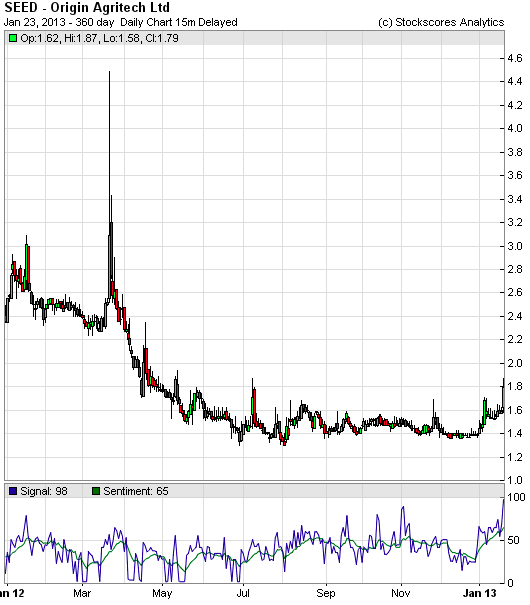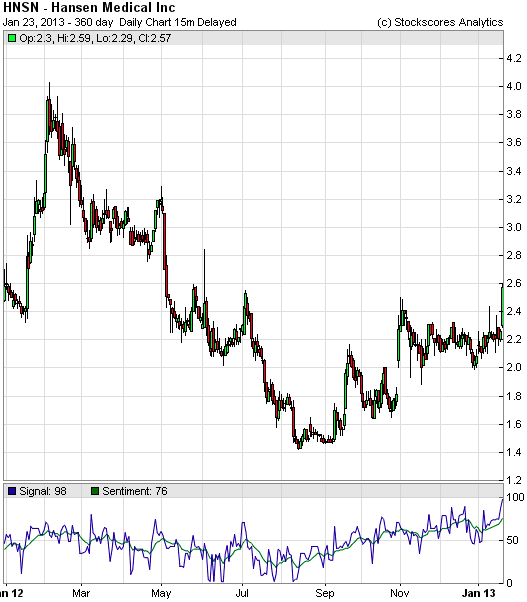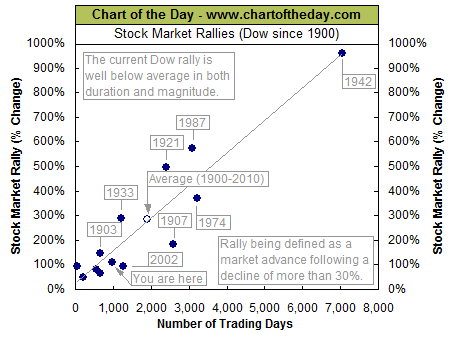Stocks & Equities
The continuing short term stock market spurt triggered by better than expected fourth quarter results has provided an opportunity to take profits on strength on a wide variety of seasonal trades (e.g. agriculture, technology, semiconductors, biotech) and to rotate into other sectors that have a history of outperformance during the January to April period (e.g. energy, platinum, copper).
Economic focus this week is on two events: the FOMC decision to be released on Wednesday and the employment report on Friday. Both are expected to have a neutral impact on equity markets.
Short and intermediate technical indicators for most equity markets and sectors are overbought, but have yet to show significant signs of peaking.
February has been the second worst performing month for U.S. equity markets during the 1950-2012 periods.
History shows that U.S. equity markets in the year after a Presidential election move higher into January in conjunction with the fourth quarter earnings report season, weaken in February and March (when tough policies are enacted) , move higher into May and close the year at a high. History is repeating in 2013.
Cash and cash equivalents continue to pile up at the corporate level, but corporations are reluctant to commit to capital expansions due to political uncertainties related to the Sequester, U.S. budget, tax reform and the debt ceiling.
From a seasonal perspective, during post-presidential election years the market has shown losses on average once earnings season concludes into the start of February. Losses top 2% between the end of the first week of February through to the last couple of days of the month. From there, the market typically bottoms between the end of February and into March, rebounding higher in April and May. Given the extent to which equity markets are overbought, some sort of pullback seems likely into February once the earnings season catalyst comes to an end. This seasonal weakness during post-election years results from the president implementing much of the tough decisions according to his campaigned-upon mandate. With deficit reduction talks continuing over the months ahead and the two key political parties remaining firm on varying degrees of balance between revenues and spending, politics could once again influence the market according to the average tendency during equivalent years. – via EquityClock.com HERE

The S&P 500 Index added 16.98 points (1.14%) last week. Intermediate trend is up. The Index closed at a five year high. The Index remains above its 20, 50 and 200 day moving averages. Short term momentum indicators remain overbought.

The TSX Composite added another 90.34 points (0.71%) last week. Intermediate trend is up. The Index remains above its 20, 50 and 200 day moving averages. Strength relative to the TSX Composite Index remains neutral. Short term momentum indicators are overbought.

The TSE Index has a history of positive relative performance between now and the first week in March.

The S&P Energy Index gained 10.19 points (1.81%) last week. Intermediate trend is up. The Index remains above its 20, 50 and 200 day moving averages. Strength relative to the S&P 500 Index remains positive. Short term momentum indicators are overbought.

Gold eased $31.40 per ounce (1.97%) last week. Intermediate trend is neutral. The Index remains below its 50 day moving average and fell below its 20 and 200 day moving averages. Support is at 1,626.00. Gold fell back after an unsuccessful attempt to break above $1,700. Strength relative to the S&P 500 Index remains negative. Short term momentum indicators are rolling over from overbought levels.

Platinum gained $18.00 per ounce (1.08%) last week. Intermediate trend is up. Strength relative to gold remains positive.

……go HERE for Interest Rate, The TSX Metals & Mining Index, Commodities, Copper and many other Charts & Analysis on Don’s Brilliant Monday Report HERE
“We are long term bullish for all major world markets, including those of the U.S., Britain, Canada, Germany, France and Japan”
DOW + 46 on 400 net advances
NASDAQ COMP – 23 on 300 net advances
SHORT TERM TREND Bullish
INTERMEDIATE TERM TREND Bullish
Another lower opening, but again buying came in immediately. However, this time the market didn’t just keep going up. It began to look a little tired. After all, the S&P 500 is up 10% since mid November. Favorable seasonality did it again.
I believe that we are close to some sort of pullback, but I’ve been thinking that for days and so far it hasn’t happened.
We’re still making a pattern of rising bottoms and rising tops on the important indices and until that changes, the path of least resistance is up.
Even the NASDAQ Composite, which has been weaker, relatively speaking, is still sporting this pattern (arrow).

TORONTO EXCHANGE: Toronto gained 30 for the day.
GOLD: Gold moved down $19. Some said it was concern the economy was getting better. I doubt that. More likely because Morgan Stanley lowered guidance for the year.
BONDS: Bonds were down slightly on Thursday.
THE REST: The dollar was up slightly. Gold, silver, copper and crude oil were all lower.
BOTTOM LINE:
Our intermediate term systems are on a buy signal.
System 2 traders are in cash. Stay there on Friday.
System 7 traders are in cash. Stay there on Friday.
Stock investors We long Intel from 21.61. We’re now down a bit. Stay with it.
NEWS AND FUNDAMENTALS:
Initial claims were 330,000, less than the expected 360,000. PMI manufacturing came in at 56.1, better than the consensus 54.0. On Friday we get new home sales.
————————————————————————————
We’re on a buy for bonds as of January 8.
We’re on a sell for the dollar and a buy for the euro as of November 19.
We’re moving to a sell for gold as of today January 24.
We’re moving to a sell for silver as of today January 24.
We’re on a buy for crude oil as of November 19.
We’re on a buy for copper as of January 22.
We’re on a buy for the Toronto Stock Exchange TSX as of November 21.

INDICATOR PARAMETERS
Monetary conditions (+2 means the Fed is actively dropping rates; +1 means a bias toward easing. 0 means neutral, -1 means a bias toward tightening, -2 means actively raising rates). RSI (30 or below is oversold, 80 or above is overbought). McClellan Oscillator ( minus 100 is oversold. Plus 100 is overbought). Composite Gauge (5 or below is negative, 13 or above is positive). Composite Gauge five day m.a. (8.0 or below is overbought. 13.0 or above is oversold). CBOE Put Call Ratio ( Below .80 is a negative. Above 1.00 is a positive). Volatility Index, VIX (low teens bearish, high twenties bullish), VIX % single day change. + 5 or greater bullish. -5 or less, bearish. VIX % change 5 day m.a. +3.0 or above bullish, -3.0 or below, bearish. Advances minus declines three day m.a.( +500 is bearish. – 500 is bullish). Supply Demand 5 day m.a. (.45 or below is a positive. .80 or above is a negative).
No guarantees are made. Traders can and do lose money. The publisher may take positions in recommended securities.
SERVICES:
We provide daily commentary via e-mail for the stock market, gold, oil, bonds, currencies and stock index futures. Available Mon- Friday after 6:00 P.M. Eastern, 3:00 Pacific. We also publish a monthly newsletter.
Our approach is mainly technical in nature. We pay attention to chart patterns, volume, overbought – oversold indicators and market sentiment. However, consideration is also given to fundamentals such as interest rates, Fed policy, earnings and the economy.
We have two main approaches. First we seek to provide specific entry and exit points for conservative investors who utilize mutual funds and ETFs. We also give precise instructions for short term traders who utilize ETFs, Options and stock index futures.
Managed Accounts
- In cooperation with Financial Growth Management, we offer a low risk bond income program. Your account would be managed through TD Ameritrade or Trust Company of America
- Your funds will be exchanged between high yield bond funds and money market funds based on a proprietary mathematical model. Our goal is to return 10-12% per year during a 3 to 5 year market cycle with very low risk.
-
If you would like more information, please contact Ray Hansen at 714 637 7784.
|
This email was sent by toddmarketforecast@charter.net
|
- What Happened To Markets The Last 15 Times The Fed Tightened. One question has gripped investors perhaps more than any other: when will the Fed start tightening monetary policy, and what will happen when it does?
Deutsche Bank Chief U.S. Equity Strategist David Bianco says, “Don’t fear interest rate normalization.” That’s the title of one of his recent research notes, which takes a deep dive into what happened to markets each of the 15 times the Fed has embarked on policy tightening since 1965.
Bianco writes, “DB economists and rate strategists forecast an unchanged Fed Funds rate until 2014. However, they forecast a 3.0% 10yr Treasury yield at 2013 end. When QE ends it will likely be akin to early-cycle Fed tightening and the uptick in long-term yields will represent a cyclical rise in rates, both of which are bullish.”
10 Things You Need To Know Before The Opening Bell
- .Asian markets were mixed in overnight trading with the Shanghai Composite down 0.79 percent. The Nikkei was up 1.28 percent after positive Chinese data boosted stocks with exposure to the country. Europe is mixed and U.S. futures are modestly lower. Apple is expected to weigh on the Nasdaq after its earnings report.
- China HSBC flash manufacturing PMI climbed to a 24-month high of 51.9 in January, beating expectations. The sub-indices like new export orders and employment also showed improvement. The $2.1 trillion powder keg near the heart of the Chinese financial system >
- In Europe, French flash manufacturing PMI fell to 42.9 in January, and the composite output index declined to 42.7, showing deeper contraction. Meanwhile, German manufacturing PMI climbed to 48.8, but remained below the contractionary reading of 50. The composite output index however climbed to 53.6.
- Initial claims are out at 8:30 a.m. ET, followed by Markit PMI for January at 8:58 a.m. ET. Analysts polled by Bloomberg are looking for new claims to rise to 360K and for PMI to decline to 54.0.Follow the release at Business Insider >
- Apple shares are down over 9 percent in pre-market trading after yesterday’s earnings report. iPhone sales disappointed, coming in at 47.8 million, against expectations of 50 million. iPad and Mac sales also missed expectations, though iPod sales came in higher. The tech giant reported earnings of $13.81 per share, on revenue of $54.5 billion. Nomura: Apple could go as low as $336 >
- Netflix also reported earnings after the closing bell yesterday. The company beat expectations reportingearnings of $0.13 per share, on revenue of $945 million. It added almost 10 million global streaming members in 2012, raising its total global streaming subscribers to over 33 million. The earnings guidance also beat estimates and its stock is up a whopping 37.01 percent in pre-market trading. Here’s what America’s biggest companies are telling us about the global economy >
- Japanese exports fell 5.8 percent in the year to December, and imports were up 1.9 percent. The trade deficit came in at ¥641.5 billion. 2012 however saw a record trade deficit of ¥6.93 trillion.
- Spain’s Institute of National Statistics put Q4 youth unemployment, defined as those under the age of 25, at 59.8 percent. Spain’s unemployment rate climbed to 26 percent in the fourth quarter, with 5.97 million out of work.
- Kansas City Fed manufacturing index for January is out at 11 a.m ET. Analysts polled by Bloomberg are looking for the manufacturing index to rise to 2.Follow the release at Business Insider >
- Lockheed Martin reported fourth quarter earnings of $1.73 per share, missing expectations. It issued better than expected full-year earnings guidance from continuing operations of $8.60 – $9.10 per share. Microsoft is expected to report earnings of $0.75 per share. Deutsche Bank: These are the 30 best stocks right now >
- Bonus – Tiger Woods is reportedly dating Olympic skier Lindsey Vonn and is thinking of getting married again.
Ignore Information, Listen to the Market!
![]()

Order the Mindless Investor book now
Have you read my new book yet? You should, I am sure it will make you a better trader! “The Mindless Investor” is not yet in stores but you can now order advanced copies of it. To do so, first log in toStockscores.com and then cut and paste this link in to the address bar of your browser. Doing so will add the charge ($29.95 + $6.50 shipping) to your shopping cart so you can complete the transaction.
http://www.stockscores.com/cart.asp?caction=add&prodid=2254
Stockscores Market Minutes Video
Where there is smoke, there is fire. Hot stocks start with abnormal activity and in this week’s Market Minutes video I show you how to spot these stocks early. You can watch it by clicking here. To receive email alerts any time I upload a new video, subscribe to the Stockscores channel at www.youtube.com/stockscoresdotcom.
This week’s Trading Lesson
In theory, information should make the stock market’s world go round. Information about companies and their ability to make money in the future is what should determine share price. As the market learns of new information, price is adjusted up and down to reflect the value of that information.
This implies that investors should focus their analysis on information so they can predict where share prices should go in the future.
While this makes good sense, I have found it to be extremely rare that investors who use information are able to consistently beat the stock market. With smaller retail investors (you and I) in particular, the use of information for making investing decisions is more destructive than it is beneficial. Here are ten reasons why:
1. Information is Usually Already Priced In – most investors use publicly available information. That means it is widely known and available to anyone considering the stock. If information is available to a large number of investors then we should expect that the market will have priced that information in to the stock. Therefore, the information has not value to us.
2. Information Usually Comes with a Bias – as a general rule, people do what they are financially motivated to do. If someone is encouraging you to purchase a stock, there is a good chance that they have some financial motivation to do so. Before you trust the information you receive, understand the financial motivation. If you find the reason, you will often usually find that there is a strong bias in the information being provided to you.
3.Trading on Truly Insider Information is Illegal – there are few risk free trades in the stock market, but trading on significant, inside information is one. You stand to make a lot of money buying stock in a company that will be acquired by another at a premium tomorrow. If you have that information and act on it, you are trading on inside information and that can land you in jail.
4. Gathering Good Private Information is Expensive and Time Consuming – there are investors who are able to uncover information that is not priced in to a stock but is not considered inside information. This private information is valuable because it can lead to market beating returns. However, gathering private information typically requires significant resources, knowledge and time. For small investors, it is not feasible to do this kind of work across a broad range of stocks.
5. Information Causes You to Ignore the Market’s Message – when you have an understanding of a company’s story, there is a tendency to fall in love with that story and ignore new information that goes against your outlook for the stock. This leads the committed shareholder to hang on to a losing position, allowing the loser to bog down the performance of the overall portfolio.
6. You May Not Have All of the Information You Need – the market tends to focus on two or three key information points that affect the price investors are willing to pay for it. An investor who does a thorough fundamental analysis of the stock may still have an incomplete understanding of the company’s business. If missing one of the key points, this investor can make a gross error in valuing the stock.
7. The Market May Not Be Trading On Fundamentals – in theory, stock price is based on the present value of future earnings expectations. In practice, there are often very non fundamental influences on share price. A large investor that has a liquidity crisis may be forced to unload a large position with little regard for price. Often, the laws of supply and demand affect share price even though theory tells us that they should not have an influence.
8. Your Interpretation May Not Be the Same as The Market’s – Our mood affects how we judge information and the same can be said for the market in general. Your fundamental analysis may be correct in an optimistic environment, but if the market is in a pessimistic mood, the investment can lead to losses. Even the market is wrong, it is right.
9. There Is No Standard for What Information is Worth – There are many formulas for determining what a company’s share price should. Many fundamental analysts look for stocks to trade at a certain multiple of their earnings with that multiple to be based on growth. However, there are great variations in accounting methods that can have a profound effect on how earnings are reported. More importantly, there is no rule that a company should trade at a certain multiple of earnings, that target multiple is just an opinion.
10. We Tend to Focus On Information That is Easy to Get – we often looks for the easiest way to achieve a goal. With information, there is a tendency to focus on the information that is front of us. Rather than work to find something to disprove our thesis on a stock, we instead look for information to strengthen our thesis. In doing so, we present our own biased outlook for our investment decisions that can often be very incomplete and wrong.
Ultimately, I look at the market’s interpretation of all available information when I look at a chart of price and volume. It shows not only every bit of information detail but also what the market thinks of it.
![]()
In this week’s Market Minutes video, I show how you can use the Stockscores Market Scan tool to find stocks trading with abnormal price and volume activity. This week, I ran a scan that used those filter and found the following two stocks which are making breaks from good chart patterns.
SEED has been a pretty boring stock lately, trading sideways and unable to get through resistance at $1.60. Today it broke through that price level with abnormal volume with a chart pattern that warrants strong Stockscores indicators. Support at $1.57.
HNSN has been building rising bottoms on its chart since September and broke out through resistance today with abnormal volume supporting the break. Support at $2.18.
![]()
1. SEED
SEED has been a pretty boring stock lately, trading sideways and unable to get through resistance at $1.60. Today it broke through that price level with abnormal volume with a chart pattern that warrants strong Stockscores indicators. Support at $1.57.

2. HNSN
HNSN has been building rising bottoms on its chart since September and broke out through resistance today with abnormal volume supporting the break. Support at $2.18.

References
- Get the Stockscore on any of over 20,000 North American stocks.
- Background on the theories used by Stockscores.
- Strategies that can help you find new opportunities.
- Scan the market using extensive filter criteria.
- Build a portfolio of stocks and view a slide show of their charts.
- See which sectors are leading the market, and their components.
Disclaimer
This is not an investment advisory, and should not be used to make investment decisions. Information in Stockscores Perspectives is often opinionated and should be considered for information purposes only. No stock exchange anywhere has approved or disapproved of the information contained herein. There is no express or implied solicitation to buy or sell securities. The writers and editors of Perspectives may have positions in the stocks discussed above and may trade in the stocks mentioned. Don’t consider buying or selling any stock without conducting your own due diligence.
The Dow just made another post-financial crisis rally high. To provide some further perspective to the current Dow rally, all major market rallies of the last 112 years are plotted on today’s chart. Each dot represents a major stock market rally as measured by the Dow with the majority of rallies referred to by a label which states the year in which the rally began. For today’s chart, a rally is being defined as an advance that follows a 30% decline (i.e. a major bear market). As today’s chart illustrates, the Dow has begun a major rally 13 times over the past 112 years which equates to an average of one rally every 8.6 years. It is also interesting to note that the duration and magnitude of each rally correlated fairly well with the linear regression line (gray upward sloping line). As it stands right now, the current Dow rally that began in March 2009 (blue dot labeled you are here) would be classified as well below average in both duration and magnitude. However, when compared to the most recent post-major bear market rally (i.e. the rally that began in 2002), the current rally has already surpassed it in magnitude and required less time to do so.
Notes:
Where’s the Dow headed? The answer may surprise you. Find out right now with the exclusive & Barron’s recommended charts of Chart of the Day Plus.

Quote of the Day
“Bulls markets have no resistance-bear markets have no support.” – anonymous
Events of the Day
January 27, 2013 – NFL Pro Bowl
February 02, 2013 – Groundhog Day
February 03, 2013 – Super Bowl XLVI
Stocks of the Day
— Find out which stocks investors are focused on with the most active stocks today.
— Which stocks are making big money? Find out with the biggest stock gainers today.
— What are the largest companies? Find out with the largest companies by market cap.
— Which stocks are the biggest dividend payers? Find out with the highest dividend paying stocks.
— You can also quickly review the performance, dividend yield and market capitalization for each of the Dow Jones Industrial Average Companies as well as for each of the S&P 500 Companies.
Mailing List Info
Chart of the Day is FREE to anyone who subscribes.
To ensure email delivery of Chart of the














